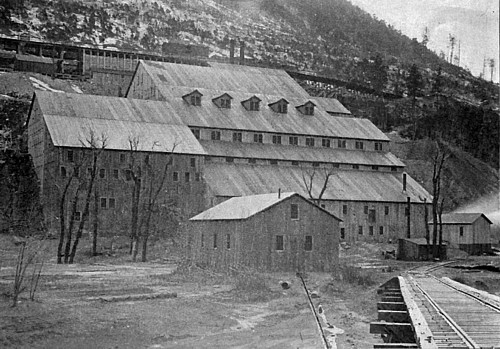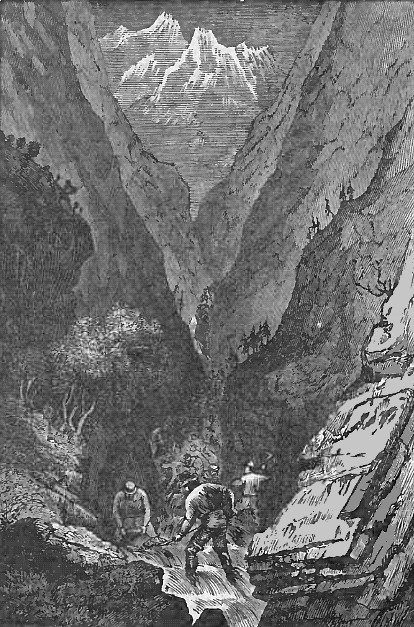CHARACTER OF DEPOSITS.
The metalliferous deposits of the Hills are both extensive and varied. Iron,
copper ore and
tin ore abound, as well as gold and
silver ore. Nor are other
mineral resources wanting. Cement, fire clay and
gypsum, as well as a great variety of
building stones, exist in inexhaustible quantities. The mines of the Black
Hills are of such a character that prospectors cannot, alone, develop their
claims into paying properties. They call, not only for the judicious
investment of capital, but for correct technical knowledge as well, and are
rather to be compared to the coal and iron industries of
Pennsylvania or the copper industry of the
Lake Superior region than to ordinary precious metal mining enterprises.
CLASSIFICATION OF
DEPOSITS.
The metalliferous deposits of the Black Hills belong to many different classes, none of which, in my opinion, can be
called true fissure veins. For some reason, as Williams has said, there
seems to be an unaccountable glamour surrounding the expression, " True
fissure vein," and a miner's first and most emphatic declaration about his
claim is apt to be that it is a " true fissure," and he often seems to think
that no higher compliment can be paid it. Now, while many true fissure veins
have paid well, the actual advantage seems to be with deposits of a
different type, of which may be instanced the Leadville silver mines, the
Lake Superior copper mines or the Rammelsberg deposit in the Harz,
which has been worked continuously for nearly a thousand years, having been
discovered in A. D. 033. It is a true ore-bed, being an independent member
of the Goslar slate series, and as I
am inclined to regard many of the more valuable deposits here as bedded
deposits, I shall give a short description of this bed, and refer the reader
to Wimmer's scientific monograph upon the subject. The Rammelsberg is a
mountain, near the town of Goslar, in the Harz, consisting of the Goslar
slate, Calceola slate and spirifer sandstone, which are of Devonian age, the
spirifer sandstone being the oldest, but now, by reason of folding, forming
the upper bed. The Rammelsberg ore deposit is found in the slate, and
consists of irregular lenticular masses of
gold ore, measuring upon the
strike of the bed 3,930 feet, and showing ordinarily a thickness of 45 to 60
feet, which, however, sometimes widens out to nearly 100 feet. It has the
same east-northeast strike as the slates, and the same dip, 45 degrees
southeast, and shares in all the folds and contortions of the inclosing
rocks. The ores yielded are various, but the originally prevailing
characteristic mineral is believed to have been pyrite.
The great deposits of the Black Hills are of Archaean age, and yield mainly an auriferous pyrite, though, as in the Rammelsberg, lead, and zinc ores occasionally occur. These deposits are sometimes lenticular in shape, and seemingly form independent members of the slate and schist series, and, like the Rammelsberg, share in all their folds and contortions, having a columnar cleavage like them, coincident with the bedding. It is to be regretted that no accepted classification of metalliferous deposits has obtained in the United States. The somewhat antiquated work of B. von Cotta has been all-powerful among the members of the mining fraternity, and Mr. Prime's translation seems to have done duty in nearly every great mining lawsuit that has occurred in the West, hence his classification is more generally known than any other. The United States Geological Survey has given us several magnificent monographs upon the Comstock, Leadville and other deposits, but no one as yet seems to have attempted for any great mining section the work done by A. von Groddeck for the Harz, and, while the extensive developments upon the fissure veins of Northern Colorado afford a field of study probably never surpassed, no one there interested seems to have improved the opportunity, though much time has been given by the United States Survey and School of Mines to more distant but probably less interesting fields.
Placers Of The Black Hills.
Two kinds of placers, that is, tin and
gold, are found in the Black
Hills. The placers are also of different ages. Quaternary and Recent, and
that ancient consolidated placer found at the base of the
Potsdam, for it seems impossible to call it
anything else. The Quaternary placers yet yield some gold, but their richer
parts, like Dead wood Gulch, are practically exhausted. Upon some streams,
where the bed-rock is deep, requiring expensive pumps and other machinery,
there may yet be found
gold nuggets in quantity. The
formation of the Potsdam rocks has partly been caused thus: The ocean
advanced upon the slowly sinking Archaean island, sorting over the material
worn from the land, re-arranging and depositing it as sand and gravel, thus
forming the basal members of these rocks. Containing particles of gold
derived from the Archaean veins, it became in reality a gold placer,
especially in the neighborhood of the great Archcean
gold deposits, such as the Homestake.
In time it was consolidated to rock, and to-day forms the "cement" beds of
the miner. It is mined, stamped and amalgamated as other free-milling gold
ore. The former contact line of the Archaean and Potsdam rocks, as well as
the subsequent erosion, is clearly shown. The porphyry capping of the vein
was injected before the Potsdam and overlying rocks had suffered erosion. It
flowed sometimes beneath the Potsdam and sometimes upon it and beneath the
Carboniferous rocks. Mr. Devereaux, who had the management of some of these
" cement" mines, was enabled to make some interesting observations, one of
which was that the gold in these conglomerates is finer than the gold of the
Homestake, whence it was derived. Since it was set free, it has been
subjected to various chemical agencies, which have dissolved out a part of
its silver alloy. This solution of silver, having been confined to the
surface of the pieces of placer gold, has given them a corrugated
appearance, and this being true, it follows that the smaller the pieces are,
the finer gold. He also observed that in the vicinity of the dikes which cut
the Potsdam, but little gold was found; and such as there was, had lost its
rounded appearance and gave every evidence of having been subjected to a
powerful solvent. As this fact bears upon the formation of other gold
deposits found in these rocks, I call special attention to the fact.
Bedded Deposits.
The Homestake and the DeSemet. These are by far the most extensive and
important of the mineral deposits of the Black Hills. The best known group of mines occupies a small section 6,000 feet long
by 2,000 feet broad, known as the "Belt," and which last year produced
$2,271,341.14. That these deposits were originally laid down as beds, I have
no doubt; but it is also certain that they were subsequently much altered.
My view of their formation is as follows:
At the time when the inclosing rocks were
laid down, large quantities of pyrite sulphide of iron were formed through
the agency of decaying organic matter, whoso presence at that time is
attested by the large quantities of carbonaceous matter yet present in these
beds. This proto-sulphide of iron was not, at least, not to any great
extent, gold-bearing. Subsequently, by the action of ferric salts, in
solution, this proto-sulphide was changed to bi-sulphide, and the iron
solutions which wrought this change also brought the gold which is now found
in these deposits. I have adopted these views for the following reasons: The
presence of such quantities of graphite is considered proof of former
organic matter. These beds of pyrite often pass into pyrrhotite, which may
be classed as a proto-sulphide of iron, and in so doing they always cease to
be gold-bearing.
The part of the "Belt " belonging to the Homestake combination is gold-bearing for a distance of 6,000 feet. The "gold ore" is not continuous throughout this distance, but occurs in shoots or vast " pipes," lenticular shaped in cross-section. The beds of argillites, phyllites and amphibole schists, in which these shoots occur, has a strike of north 37f west, which is also accurately the strike of the plane or " ore channel " in which the shoots occur. The dip of the beds, as a whole, is to the east. The shoots dip east also, upon, but athwart this plane, at an angle of about 45 degrees. The ore and inclosing rocks have indifferently the same general cleavage structure.
In the Homestake proper, or south end of the Belt, there are numerous sheets of porphyry, or more properly, of felsite, sometimes cutting across the stratification, but usually parallel to it. In the northern half — that is, the Deadwood-Terra and DeSmet end — no porphyry is found in the vein, but the section was once overlain by a felsites which yet remains as a capping to the ridge between Gold Run and Bobtail Gulch, and between Bobtail Gulch and Deadwood Creek. This porphyry was injected between the slates and the Potsdam, raising the latter and other overlying rocks after the manner of a laccolite, though they have since, in the immediate area, been removed. The vent through which this sheet was injected had probably no connection with the small dikes found in the Homestake, but was intruded from the southwest, and most likely was connected with the igneous mass forming Terry's Peak.
The percentage of pyrite impregnating the slates and schists and forming the "ore " is never large. The yield upon concentration is seldom 20 per cent. The average is probably not more than 7 per cent. There are no solid bodies of pyrite. The influence of the porphyry upon the lode seems to be good, but whether it produced an enrichment of the bed, or simply rendered it, by some action, oxidizing or otherwise, more free-milling, I did not determine definitely. The fact, however, is, that the Homestake yield per ton is much greater than that returned by the Deadwood-Terra and other claims where the igneous intrusions do not occur; the former, from the best attainable data, being $3.87 per ton, while the latter lies between $2.03 and $2.82. The sheets of igneous rock in the Homestake are porous and much decomposed. Careful assays showed no gold. The sheets east of these, near the pump shaft, are pyritiferous and assay from $1 to $2 per ton. From what I have stated, I am led to the conclusion that the porphyry has had a twofold benefit: First. It has rendered the ore more free milling. Second. It has in its neighborhood produced either an enrichment of the deposit or a further concentration of what gold originally existed in it.
That it was gold-bearing before the injection of these dikes is proven from the fact that remote from their influence it is gold-bearing, and that all similar beds through other parts of the Hills where no igneous rocks occur, are also gold-bearing ; as well as from the evidence furnished on preceding pages from study of the Potsdam conglomerate, which, as has been stated, was laid down prior to their injection. At the surface the ore has always appeared in shoots, as I have described, but lam credibly informed that in the deep workings of the Homestake end this is no longer the case, the bed being now continuously ore-bearing for many hundreds of feet. These ore-bodies are said sometimes to have exceeded 300 feet in thickness. Careful measurements of the big open cut upon the Golden Star claim gave as the cross-section of that body 150x350 feet, while the Terra cut gave 150x250 feet. These measurements are probably correct so far as the width is concerned, but the shoots may be longer.
Return
to The South Dakota Page:
South Dakota Gold Rush History



